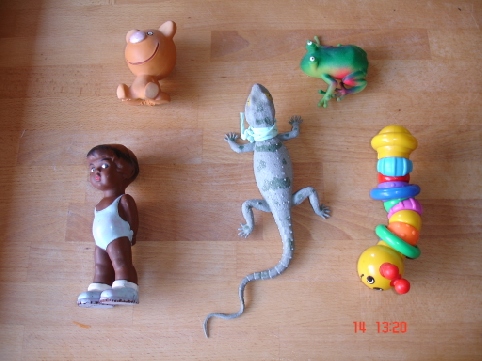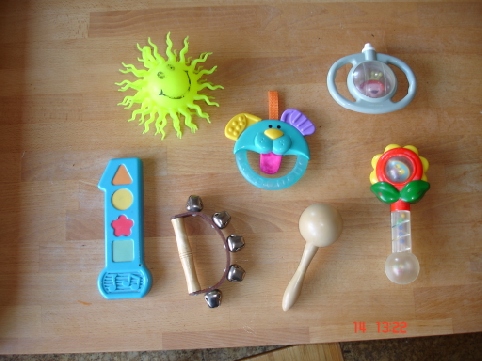(part of the fine motor skills)
To establish that we have to work on TWO things at the same time:
|
To master |
To master |
Definition: Vision is the process of understanding what we see with the eyes.
It involves: acuity (ability to distinguish fine details); fixation and eye movement abilities, accommodation (focusing), convergence (eye aiming), binocularity (eye teaming), and the control of hand-eye coordination.
Vision imparement in Rett syndrome is neurological.
It originates from the brain and not from the eyes itself but it effects all (or some) muscles of the eye. Impaired vision necessarily affects a child's hand-eye coordination, as well as cognitive and physical development by limiting the range of experiences and the kinds of information to which the child is exposed. It effects perception of the depth (third dimension of the space), learning that is in direct relation with long and stabile looking, understanding of the relations between objects/toys. It depends of the vision how a child understands and functions in the world. Most hand movements require visual input to be carried out effectively.
Research shows: Looking at the hands is essential
A typical recording of a newborn baby waving both arms with no weights attached is shown in Fig. 1C. The seen ipsilateral hand shows much movement, whereas the unseen contra lateral hand is predominantly stationary with only occasional movement. To test whether newborns need to see their hand to move it in the same region despite the force tending to pull it away, we divided the babies into three groups:
The babies in group 1 could see only the ipsilateral hand (Fig. 1A).
The babies in group 2 were prevented from seeing their arms directly, but were presented with a real-time video image of the contra lateral arm on a small monitor placed beside their head.
The babies in group 3 had occluders at the sides of the head which prevented them from seeing either arm.
The results show that the newborn babies moved a hand up and down in the same place despite the pull of the string on their wrists, but only when they could see the hand, either directly or on the video monitor:
When a hand was invisible it was pulled down by the string. In addition, the amplitude of movement of a seen hand was significantly larger than that of an unseen hand. Instead, while watching their moving arms, newborn babies acquire important information about themselves and the world they move in - information babies need for later successful reaching and grasping beginning at around 4 to 5 months. To successfully direct behaviour in the environment, the infant needs to establish a bodily frame of reference for action. Because actions are guided by perceptual information, building a frame of reference for action requires establishing information flow between perceptual input and motor output. It also requires learning about bodily dimensions and movement limitations. Here vision plays an important role, and many lessons in practical optics have to be learned in the early weeks before reaching for toys can emerge. Infants have to learn, for example, how long their arms are in order to perceive what is within reach and what is out of reach. It seems likely that a fast growing infant will need constantly to recalibrate the system controlling movement, and visual proprioceptive information is least susceptible to "growth errors".
The Functional Significance of Arm Movements in Neonates, A. L. H. van der Meer, F. R. van der Weel, D. N. Lee
Perception in Action Laboratories, Department of Psychology, University of Edinburgh,7 George Square, Edinburgh EH8 9JZ, UK.
VISION STIMULATION PROGRAM for DEJANA
As most girls with classical Rett syndrome Dejana had vision dysfunction. She had side vision, a short watching span and slow reaction of pupils on light. She could not stand sunlight and could not follow an object moving around her more than 30 degrees. Following objects that went up was not possible and following down was not consequent.
With this kind of imparement it was not possible for her to look at her hands at all or to focus on the toys in front of her. Following one long action of play is essential for learning. Without that learning is impossible! When I discovered that we started to work on her vision. She got a number of exercises from BIBIC and I ordered a set of special tools from the Clinician's view.
We worked on it daily and it included watching lights in a dark room, following toys with bright colors or sound and grasping small objects from big case boards that were standing or moving.
Dejana concentration span was not more than 10 seconds in the beginning but it rose till several minutes at a time. When she mastered it it become a fun to her. Then we started with following different objects in the normal room light with crowded background and this is exercise that we are still doing. She is sitting on the chair that rotates slowly while one person walks around with a book or toy and she has to follow the object with steady look and and fool concentration. She can already do it for almost 180 degrees both sides (left/right)
Her vision is now close to normal. She looks at a far objects in the nature with long concentration and recognition, follows bicycles or birds (up and down) looks from one picture to another in the page of the book and the sun is not more unpleasant to her. Dejana covers now with her view the whole object and the details within it what she could not do before. She can watch a short sequence of our daily activities what makes more easy for her to understands and learns them. She can also search for the peace of biscuit that felt down from her hand and take it again with persistence.
Our vision program took us more than two years and now she can master it further on her own through daily life activities without special support from our side. My final goal in this area is to prolong her watching time and to establish her full hand-eye coordination but it is a new skill in development.
Important to mention:
– there are now a days good computer programs for vision exercises but working with real toys is still the best.
– watching videos and TV is not stimulative for vision.
– if she is turning her head aside that does not mean she lacks interest in play this turning is mostly reflexive.
Definition: Hand-eye coordination is the ability of the vision system to coordinate the information received through the eyes to control, guide, and direct the hands in the accomplishment of a given task, such as handwriting or catching a ball.
Hand-eye coordination uses the eyes to direct attention and the hands to execute a task.
Normal development: Between four and 14 months of age, infants explore their world and develop hand-eye coordination, in conjunction with fine motor skills. Fine motor skills are involved in the control of small muscle movements, such as when an infant starts to use fingers with a purpose and in coordination with the eyes.
Infants are eager to move their eyes, their mouths, and their bodies toward the people and objects that comfort and interest them. They practice skills that let them move closer to desired objects and also move desired objects closer to themselves. (That explorative stage of development is missing in the Classical Rett syndrome). By six months of age, many infants begin reaching for objects quickly, without jerkiness, and may be able to finger feed themselves. Many infants are also able to look from hand to object, to hold one object while looking for a second object, and to follow the movements of their hands with their eyes. At this age, most infants begin to poke at objects with their index fingers.
After six months, infants are usually able to manipulate a cup and hold it by the handle. Many infants at this age also begin to reach for objects with one arm instead of both. At about eight months of age, as dexterity improves, many infants can use a pincher movement to grasp small objects, and they can also clap and wave their hands. They also begin to transfer objects from hand to hand, and bang objects together. These activities are extremely important for the development of hand-eye coordination and cognition.
HAND-EYE EXERCISE PROGRAM for DEJANA
Because Dejana had very poor hand function we decided to teach her how to use her hands and arms starting from the very beginning of the normal (typical) human development.
____ Typical infant: Ten-week-old child lies on her back watching the toys of her activity gym hanging above her. She focused on the colorful toy hanging within reach of her hand and then suddenly, she stretches her hand out and swung it towards the toy and … missed. But the child does not give up. She pushed her hand out again trying to hit the toy. This time her hand hits the right spot and the toy swung back and forth.
This child was working (on her own) on developing the coordination between her eyes and her hand. She was trying to learn how to bring her hand directly to the object she was focusing on. She was busy with purposeful action in her first play and she was aware of things that she is doing. In the very beginning her movements were reflexive and accidental, but as soon as she understands what happens, she will take over the action under her control. Typical baby will do it all by herself, but Rett child will never make it on her own. Thats why we have to help this process and we have to start with therapy: exactly at this point of development if we want to make her aware of her hands and their possibilities.
____ Girls with classical Rett syndrome: (as newborns) don’t associate what their eyes see with what their hands do. Often their eyes look in one direction, while their hands move randomly in another. They (like young babies) don't move their hands toward an object they see. They are unaware that these hands, which belong to them, are part of their bodies. Most of the time their hands are outside of their vision, and they are not even aware of them.
Rett girls (before any occupational therapy starts) first have to discover that they have hands. This usually happens at about six to eight weeks in the normal development when babies discover their own hands by touching them. They grab one hand with the fingers of the other hand. They pull on them, and open and close their fingers. At this stage, their movements are usually random; they don’t yet lift their hands in front of their eyes to intentionally look at them. When they reach three months of life they will be able to include the vision in their hand play.
And this is exactly where we have to start our therapy with Rett girl if we want .. to be effective. She already has her hands in play but it becomes a stereotype and she will never make the next step on her own: to switch her eyes on her hand movements. She will stay locked at the early stage of development just before the eye-hand coordination was established. But we can try to stimulate her further progress by an individual therapy programme that mimics normal developmental mile stones.
Important tip: I would like to explain how I worked with Dejana on establishing her fine motor skills. Before I start about the details of her exercises I need to say that: most therapists start with too complex hand skills (building tower with blocks, simple puzzles, forming clay, putting rings on the stock and even drawing hand on hand !!! sic!!) Such therapy will always fail and it will be very frustrating for the girls. Why? Because she does not have the necessary background to do that. She has first to become AWARE of her arms, hands and fingers, before she can manipulate the objects in such a fine way. But therapies that are stimulating basic fine motor hand skills don't exist yet. I had much trouble to find anything in this early developmental area but finally I succeeded. I asked myself which stages she had to pass in therapy?
First step: LEARNING TO LOOK AT HER HANDS
The child is laying on her side (also if she can sit or stand and walk!) looking at the wall or at a large colored panel. It has to be a warm friendly color and must be in contrast with the color of the girl's skin so that her hand becomes very visible (dark skin with light panel / light skin with dark panel).
Laying is important because the girl does not have to deal with the gravity of the body and head so that her all concentration can be focused on her hand movements. In this way we can also easily keep her head in the best position for long looking to the wall/hand. We have to take one her hand at a time and try to move it over the service of the panel, to bump her hand strong on it, or to press with her hand deeply against the wall as a game. Music can be included and we can use different panels with all kinds of structures but always one per section.
We also have to take care that she looks as much as possible and as long as possible at her hand actions (which we perform holding her lower arm). Movements can be rather strong than soft because she can feel them better. They have to provoke deep sensation that girls with Rett usually don't have. The playing session has to be long as she can tolerate, with some breaks in between. The next time we will lay down on her other side in order to let her other hand to get a chance to play. It can take several weeks/months before she starts to follow her hand and starts to watch it on the background, sometimes laughing and maybe even trying to move it on her own.
Second step: LEARNING TO STRIKE and TAP
When she has learned to intentionally bring her hands within her vision, they will become her most fascinating toy. Then: our first goal is achieved. She is looking at ONE hand for a long period of time while we are moving it across the surface. Now we have to stimulate her to start tapping or moving her hand/fingers on her own without our help. Movements have to be deliberate, single, slow and good controlled like a movement of a typical child (not reflexive, repetitive and jerky) . Only if we succeed in it completely we can to introduce a new step in development
Third step: LEARNING TO TOUCH
After discovering their hands, Rett girls need to learn that they can activate them and make use of them. It is NOW important to hang one toy at a time that can be batted or struck, at the surfes of the panel in front of whom she lies. I always used clear simple forms, shining or bright colored, that can rattle or have a nice structure and I changed objects when she lost her interest in it. It is important to avoid batteries and electronic toys. When girl lies on her side looking at such a toy (one at the time) she will focus her eyes on the toy and look at it gleefully. At the same time, she might move her hand randomly until her hand will touch a toy and the toy will swing and rattle.
Our role is to help her hands hit the toy more often so that she will begin to understand that she can control the process, and the random hitting can become more and more intentional. Her hand has to be open and her fingers flexible. When she learns to do it with the purpose every time and when this becomes the game for her with enjoying and laughing on the right moments, than she mastered this developmental step. This is when hand-eye coordination is starting to establish. The movements will not jet be smooth enough and may still be sudden and jerky but playing with an object and using her hand has to be PURPOSEFULLY most of the times. If this is so we are ready for the next step.
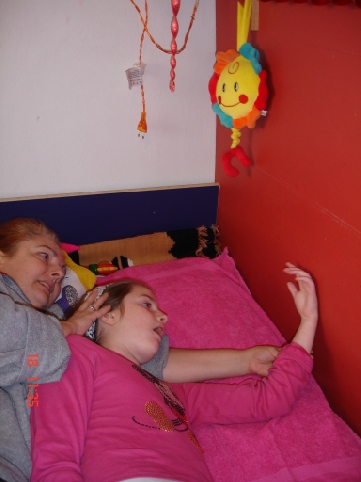
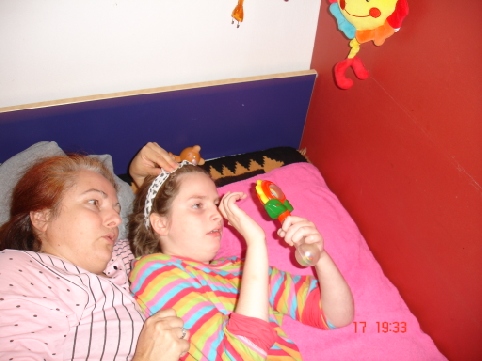
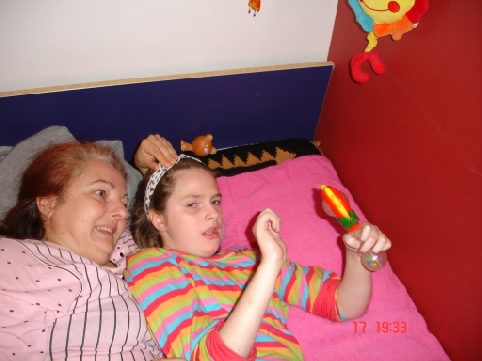
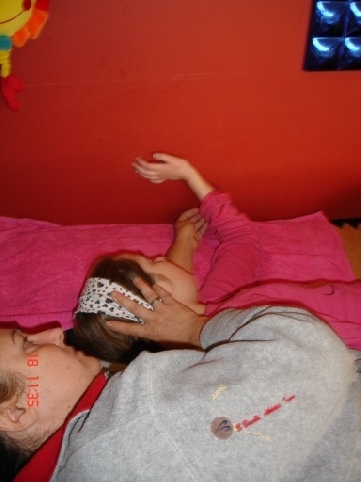
Once hand-eye coordination has improved she may want to grasp the objects (not only to hit them) so she needs to assess the distance between herself and the toy that she wants to touch. She has to move her eyes from her hand to the object, and back again to assess the distance. Gradually, this process becomes more accurate and she can stretch out her hand directly to the object and touch it without hesitation. It is important that she does it calm and natural without moving all body parts but only the arm. The rest has to be quiet for a wail. This phenomena is called: fixation body for the movement. She also has to look at hand and object carefully.
We can help her calm down and do it slowly by placing our hand on her arm to do it together for a few times. Than we can let her do it a few times on her own and if necessary help her again. The position of laying is the same (one section on the left side and other section on the right) but the surfes with hanging toy can be placed on the different distance so that she has to stretch her arm sometimes and to learn about the position of the object in space. After some months of training/playing, Rett girl can bring her hand directly to an object within reach and grasp it at just right moment and even hold it for longer period of time (10-15 seconds) without jerky movements. She will watch her actions and will be seriously concentrated at her simple play.
At this stage she also needs to have something that does not’t move on the rope but is fixated on the surfes, so that she can reach out and touch without it swinging and slipping away all the time. Many different tactile toys can be used even two or tree at a time so that she can grasp, stretch, point, squeeze.. etc but we can still help her to perform this actions. If she starts to master that all she is ready for the new step.
Fifth step: LEARNING TO HOLD FREE OBJECTS
As she can grasp and hold objects hanging on the rope for at least 10 seconds while watching them with normal attention we can give her now a free object. It is good to chose a light long toys that can be held and make sounds when shaken. They draw child's eyes and attention to what they are holding in their hands. The position for exercise does not have to change jet.
Child is laying again on the floor with her face to the side and we are laying next to her. Bright shiny objects that make noise, such as a rattle, should be put into child’s hand right or left (depends on the side on which she is laying). If she has a grasping reflex, she will automatically clasp her hand around an object placed in it. Then, she might move her hand randomly but she will hear the rattling noise and look for the source of the sound with her eyes maybe for a seconde. We should help her hand stabilise for a short time in front of her eyes and repeat a few times. Then left her hand free for a while and do it again several times in one session. We have to stimulate this process (games) until she can focus on the rattle for long time (10 sec or more) without dropping it and start to bring it up by herself to look at it with the purpose. Than she is ready to discover her hand holding thinks. We can help her to grasp longer by holding her hand with ours but we have to be careful not to cover her own hand because we want her to see it clearly. The best is to take her lower arm far from the hand and/or to use gloves in the color of her skin.
It can take weeks or even months before we successfully reach that goal so we have to be patient and calm with a lot of creativity and we should use different, but always simple and attractive objects. Attention has to be put on her hand that holds the toy and less on the toy itself.
Next exercise:
You should hold out objects in front of her to touch/grasp while placing it in different positions, so that she can further improve her hand-eye coordination. You can shake a rattle within hands-reach while she is lying on her back or on her side so that she will have to stretch in order to reach it. Up till now all exercises ware done only with ONE hand at a time and if she mastered striking, tapping, grasping, holding and shaking it is time to include both hands in action.
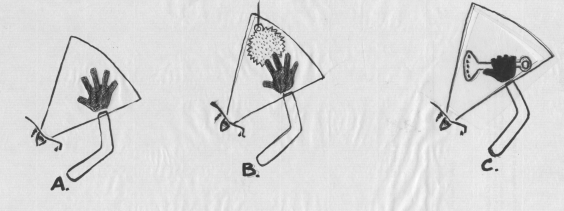
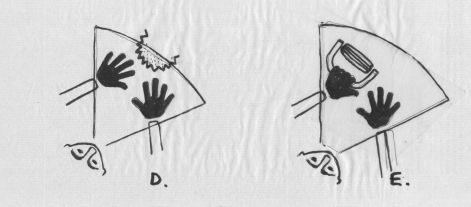
Sixth step: LEARNING TO USE BOTH HANDS TOGETHER
Till this moment toys were most of the time fixate on the static surface or rope to avoid her reflexive throwing them away. Throwing away does not mean that she does not want them but that she can not control her arm movements. Using two hands together and looking at them at the same time is extremely challenging for every girl with Rett syndrome. It needs months of daily practice before we can see some results and we have to be very patient and creative. If we both experience that as a playing session it will be a joy for us and not an obligation. The "Son-rise" attitude is here essential.
The best position for play/exercise is laying on the beck with a fixed board in front of her. We can sit behind her head in the position that allows us to hold her both arms to help. All surrounding has to be empty so that her concentrate stays on her hands. In the beginning should be used one lear, simple toy with good expression, color, or sound (not electric!).The toy should be fixed at a board with a rope so that it can move a little.
The task for her is to touch it with BOTH hands at the same time, to grasp it or to hold it for a while. The best is if the toy is so big that it can be grasped with both hands at the same time (15-20 cm). We have to help a lot in the beginning and to take care that her head is positioned in such way that she can fox use her eyes directly on the toy, hands and board. I made a drawing of the positioning that we used:
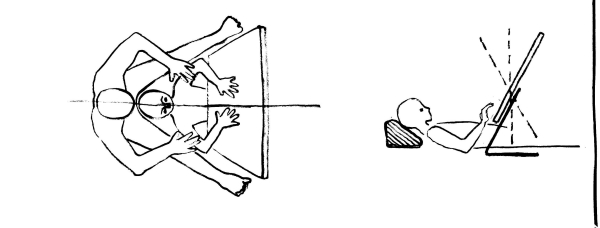
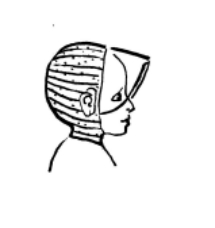
When she starts to make normal, smooth, slow and coordinated movements and looks peacefully on the hands and when it all looks like an action of a typical child, than we can say that she mastered that developmental skill. Now she is ready to use her hands in a SITTING position.
Next exercise:
After months of fine motor hand exercises while laying we are finally ready to do them while sitting. It is best to sit at the floor in the beginning and then slowly transfer to a table for short periods of time. We have still to assist her by sitting behind her beck but up till now she will be able to use her hands much on her own and to deal with the gravity of her upper body and the head. We can verbally prompt her to grab, shake, hold a toy with both hands and we can use more toys at the same time. They can be different in size and or structure and all that we have to expect of her is to show interest in them and to simple manipulate them sometimes.
In this stage with Dejana we included one more person that was sitting opposite to her and was asking her to take a toy, to give it to him, to hold a ball and to throw it towards him. He also gave her a ball from different positions in the space (up, down, left, right) and she had to stretch her arms in all directions. We stimulated her to grab an object that is moving, to hold a toy with two hands at the same time or to find a hidden ball. In that stage of development we can create as much games as we can imagine. It is funny and pleasant. It does not feel like an exercise any more because she will show some initiative, something that is NOT at all usual in Classical Rett syndrome. When Dejana reached this point in development her hands discovering was completely achieved. This was a time when we got new, even higher, therapy goals and I will explain them in the following chapter called: PLAYING TOOLS
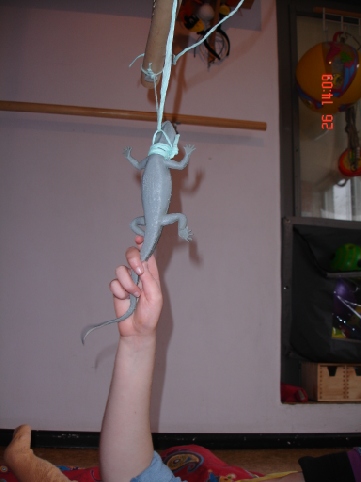
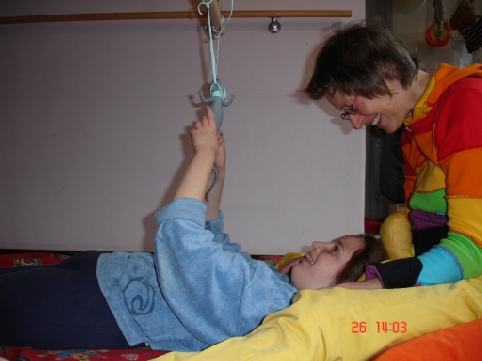
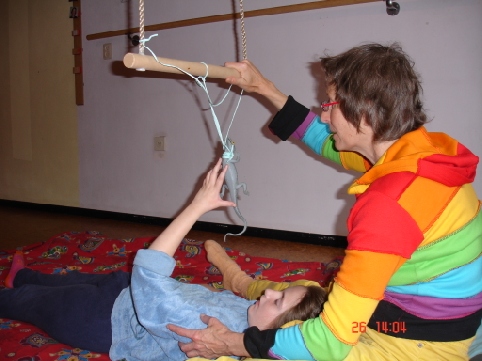
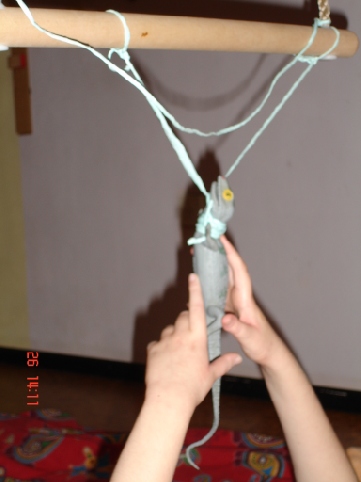
that she makes simple exploring movements on her own; that she looks at her hands in action;
that her arms/hands move voluntarily, smooth and coordinated;
that she moves her fingers separately; that she grasps and holds toy natural;
that she has many variations in using her hands and that she uses both hands equally good.
1. It is essential that she looks at her hands in action
2. We have to position her head in the good direction
(sudden turning head in Rett syndrome is reflexive, it is not a voluntary action)
3. Stereotype has to be minimised during the exercise and if this is not possible we have to work shorter
4. The best position is laying on the back or side to avoid gravity tension
5. The whole body has to lay in an absolutely correct (symmetric) position
6. If we want that she gets some arm/hand functioning this kind of therapy program will be the ONLY way to (maybe) achieve that because it addresses the basic skills. Without them all higher skills will be impossible to learn.
7. Hand exercises may provoke epilepsy or dystonia attacks in the beginning
